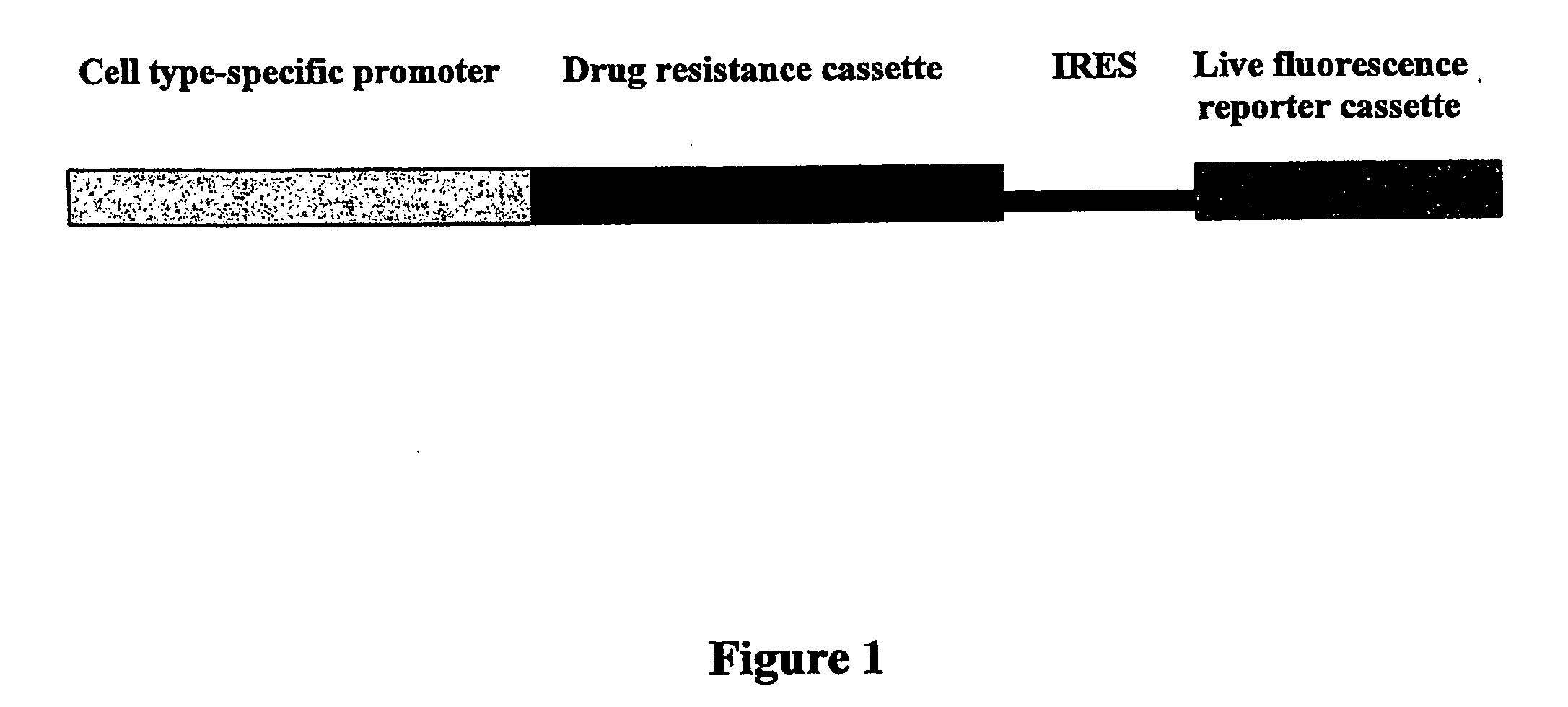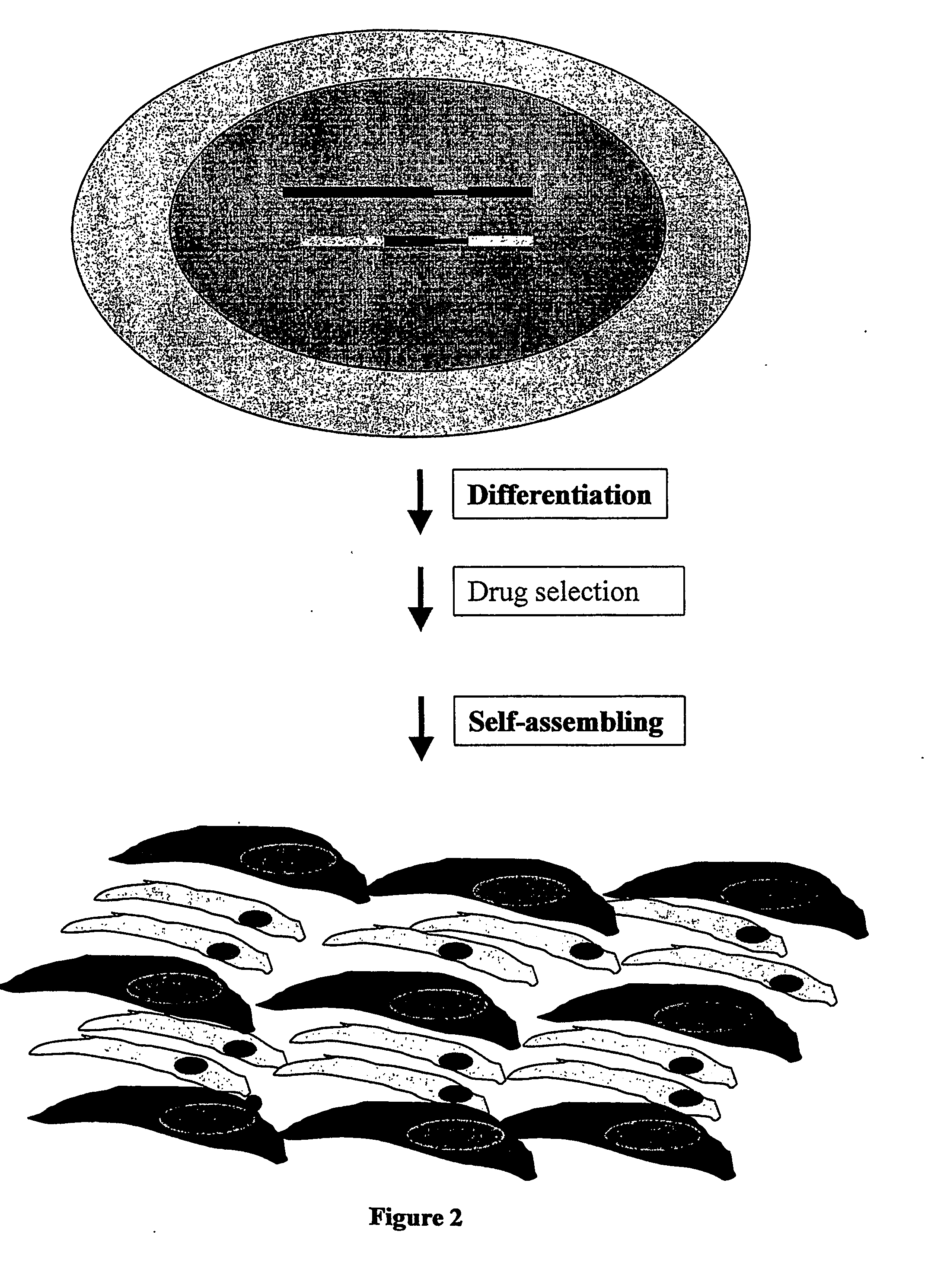Tissue Modeling in Embryonic Stem (Es) Cell System
a stem cell and embryonic stem technology, applied in the field of embryonic stem cell system tissue modeling, to achieve the effect of reducing the threat of tumor development and improving transplantation results
- Summary
- Abstract
- Description
- Claims
- Application Information
AI Technical Summary
Benefits of technology
Problems solved by technology
Method used
Image
Examples
example 1
Generation of the transgenic ES cell clones for drug selection of the ES cell-derived cardiomyocytes
Design of the Vector
[0172] The 5.5 kb BamHI-SalI fragment of promoter region for cardiac-specific α-myosin heavy chain (αMHC) (GenBank accession No: U71441; Subramaniam et al., J. Biol. Chem. 266 (1991), 24613-24620; Sanbe et al., Circ. Res. 92 (2003), 609-616) and coding region for puromycin-resistant cassette (Pac) have been inserted consequently in the multicloning (MCS) site of the pIRES2-EGFP vector (Clontech®) after human cytomegalovirus (CMV) early promoter (PCMV IE) has been excised by AseI-Eco47 III. In resulting bicistronic vector (pαPIG) cardiac-specific αMHC promoter drives expression of both Pac as a drug selective marker and enhanced green fluorescent protein (EGFP) as a live reporter gene. The IRES (internal ribosome entry site) sequence provides the separate translation of both proteins in stably transfected cells. The vector contains also the kanamycin- and neomyci...
example 2
Co-Cultivation of the Purified ES Cell-Derived Cardiac Cells and Mouse Embryonic Fibroblasts
[0176] After 7 to 10 days of the puromycin treatment, the beating EGFP-positive clusters of cardiac cells have been collected by centrifugation, washed twice with PBS and treated with 0.1% of collagenase B (Boehringer, Mannheim) during 20 min at 37° C. After 10 min and at the end of incubation cell suspension has been gently pipetted through the blue tip of 1 ml pipette. Consequently, one, two and again two volumes of medium containing 20% of the fetal calf serum (FCS) have been added and cells were centrifugated and washed with this medium twice, resuspended and calculated under fluorescent microscope.
[0177] Mouse embryonic fibroblasts have been obtained from 14 to 16 d old embryos accordingly to standard procedure, see, e.g., Joyner A. L. Gene targeting. A Practical Approach. Oxford University Press, 1993. Cells were grown to the confluent and trypsinized with 0.05% trypsin, washed twice ...
example 3
Co-Transplantation of the Purified ES Cell-Derived Cardiac Cells and Mouse Embryonic Fibroblasts
[0178] The mouse line SV129 has been used for preparation of embryonic fibroblasts by standard procedure (see, e.g., Joyner A. L. Gene targeting. A Practical Approach. Oxford University Press, 1993) in order to match the origin of the ES cell clones used for generation of cardiomyocytes. 50×103 to 100× 103 of both purified cardiomyocytes and fibroblasts have been mixed and injected to the cryoinfarcted hearts of SV129 mice as described in Roell et al., Circulation 105 (2002), 2435-2441. The cardiomyocytes displaying both EGFP fluorescence and cross striation have been detected in transplanted hearts during the time frame of 10 to 70 days after operation (FIG. 6) thereby confirming viability of the engrafted ES cell derived cardiac cells.
PUM
| Property | Measurement | Unit |
|---|---|---|
| Time | aaaaa | aaaaa |
| Color | aaaaa | aaaaa |
| Structure | aaaaa | aaaaa |
Abstract
Description
Claims
Application Information
 Login to View More
Login to View More - R&D
- Intellectual Property
- Life Sciences
- Materials
- Tech Scout
- Unparalleled Data Quality
- Higher Quality Content
- 60% Fewer Hallucinations
Browse by: Latest US Patents, China's latest patents, Technical Efficacy Thesaurus, Application Domain, Technology Topic, Popular Technical Reports.
© 2025 PatSnap. All rights reserved.Legal|Privacy policy|Modern Slavery Act Transparency Statement|Sitemap|About US| Contact US: help@patsnap.com



